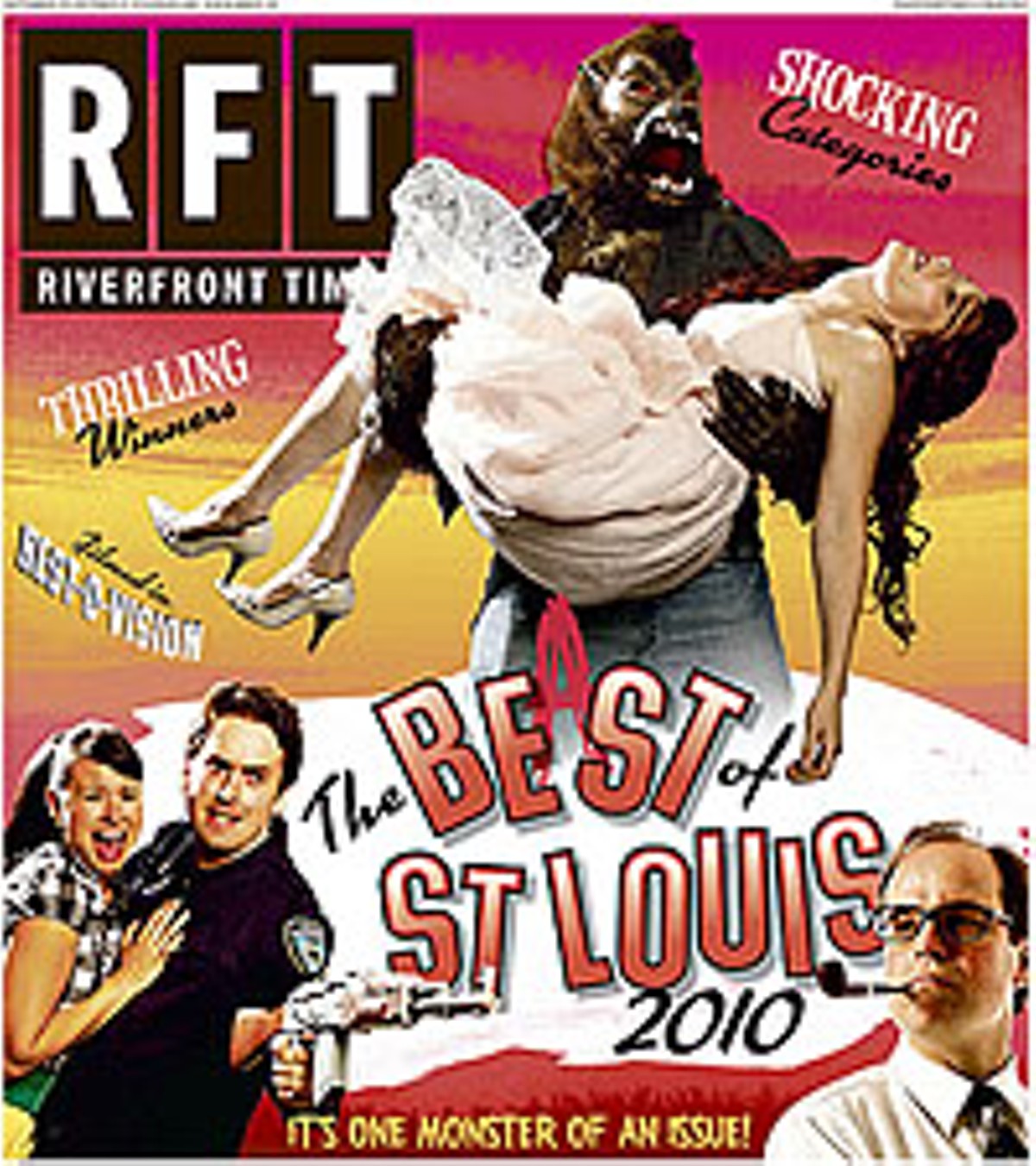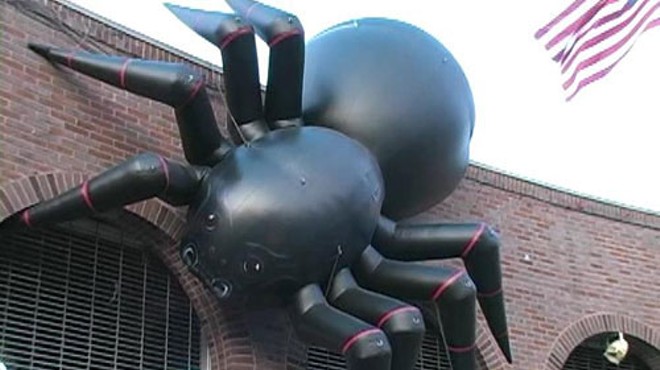It's impossible to describe Nikki Glaser's comedy without reference to Sarah Silverman, whose influence on the 26-year-old blonde from Kirkwood is blatant (both skip gleefully into the taboo pastures of rape and abortion). But while Silverman assumes the persona of the naive boor in order to lampoon A-listers and all things PC, Glaser offers a different emphasis: She sounds like a sweet sorority girl relishing her own depravity. ("Before I used my vibrator, I used my electric toothbrush.... Don't judge me! My vagina had never been whiter or more tartar-free.") Last year she landed a slot on Leno; more recently she appeared in the documentary I Am Comic alongside the art form's heavyweights. Rumor has it Glaser has developed some new material concerning her female parts that recently destroyed the Wednesday-night crowd down in Brennan's basement (4659 Maryland Avenue; 314-361-9444). May she continue to climb upward in her race to the bottom. That's how we like her best.
Previous Winners
Drive past 2720 Cherokee Street on most weekend nights, and you'll find a gaggle of people, from teenagers through thirtysomethings, lined up on the sidewalk to gain access to the club. Though 2720 has been in operation for a little less than a year, its magnet-like ability to draw in music fans is due in no small part to the efforts of Joshua Grigaitis, the man behind the Loyal Family brand of show promotions and event planning. Known to most as Joshua Loyal, Grigaitis got his start in the business through booking shows at his father's Hill-area tavern, Pop's Blue Moon. Since then his shows have broken out of the jam-band scene and have come to encompass bluegrass, hip-hop, funk and DJ performances, and his space at 2720 Cherokee serves as a big, blank canvas for Grigaitis' come one/come all approach to throwing memorable events and uniting music lovers.
The Pulitzer Foundation for the Arts stays true to its name: "arts," plural. The curators are nothing if not multidisciplinary, incorporating poetry readings, theater and musical performances into exhibits of visual art. "Incorporate" is the right term; the foundation's mission has always been to blend the work on display with the building's architecture, and to direct the viewer's thinking to the community beyond the museum's walls. The result is a space that continually changes, cared for by people who see the venue as anything but a mere repository of pretty things.
Elizabethe Holland was awarded a prestigious Gerald Loeb Award in 2010 for her teamwork on a series of articles exposing the shady transactions of auto-warranty firm US Fidelis. But that's not why Holland caught our attention this past year. More impressive was Holland's dogged coverage of the shenanigans within the Northeast Ambulance and Fire Protection District. Holland's reporting revealed how the fire district's attorney, Elbert Walton Jr., billed the agency outrageous fees of hundreds of thousands of dollars while his cronies on the board awarded themselves with lucrative perks and payouts. Holland's articles eventually led to a state audit; auditor Susan Montee called the fire district a "poster child" of bad government, and a judge froze the board's checking account.
This solo exhibition by local artist Erik Spehn featured a suite of large-scale paintings deploying his signature abstractions of obsessively woven textures, but with new strains of scarlet and underpaintings of golden maize. The added color infuses depth and a kind of emotional narrative to work otherwise intent on the study of restrained, process-oriented subtlety. Thin strands of cut canvas, or lines of paint pooled between taped-off guidelines, created textile-like surfaces, tight gridworks of the most delicate pigment. But the grid would veer off asymmetrically, almost at the will of a strain of deep color. Or it would breathe with suffused light — in hues of yellow — off-setting the reticent procedural framework of the repetitive marks. As a whole, the exhibit had the impact of a musical piece, in which the intricate motifs, perhaps those most identifiable with the musician, cut loose sounds revelatory to his own ear and, as such, seem to herald a new stage of mature and virtuosic expertise.
It all comes down to what you want from your theater. If you're seeking escapism, a good time, a few laughs or an easy lump in the throat — and there's nothing wrong with any of those nice things — then you might want to look elsewhere (and there are lots of options). But if you're open to having your mind stretched and your complacency challenged, if you welcome storytelling that is a little less conventional, then Upstream Theater should have a valued place in your theatergoing life. Upstream stages plays that enlarge our comprehension without necessarily providing answers. We don't want to condemn Upstream with a lofty term like "artistic," but the company's productions are usually beautiful to view. Even if you don't immediately like a particular show, there's a good chance it'll linger in your mind and haunt your heart. Not always the easiest theater, but usually the most edifying in town.
Passionate theater, persuasively rendered, was the stock-in-trade of the Orange Girls theater company, which concluded its brief but exhilarating four-year tenure with an effervescent production of David Lindsay-Abaire's madcap comedy Wonder of the World. In the pivotal leading role of a rudderless woman on the run from reality, Brooke Edwards somehow managed to anchor the anarchic evening even as she was cavorting about as a crazed loony. As Cass, a married woman who initiates a love affair with the captain of the excursion boat Maid of the Mist, Edwards etched her bizarre portrait in so disciplined a manner that she also guided the show's momentum. If the (already missed) Orange Girls company was created in part to showcase actresses in delicious roles, Edwards rose to the challenge. In a performance whose energy never flagged and whose control never wavered, she delivered the stage equivalent of tightrope-walking across Niagara Falls without a net.
Beside the swimming pool in which the magnificent hippopotamuses laze about their days at the Saint Louis Zoo is a simple interactive display: Turn a crank and the tail of a cartoon hippo spins, scattering its poop among the small fish swimming around it. The point is to educate zoogoers about the food chain. The smallest fish feed on the poop and are in turn eaten by bigger fish, which are in turn eaten by even bigger fish, and so on until the biggest fish is caught by humans and becomes dinner. Yes, the food chain is a handy metaphor for how the elite few make their millions on the backs of the working class, but that isn't quite the metaphor we mean. No: Take a closer look at the littlest fish scattered about the hippo's scat. They are smiling. And why not? If you eat shit your entire life, you might as well wear a shit-eating grin.
Theodore's latest release, Hold You Like a Lover, is at once foreign and familiar, homesick and homeless, gorgeous and damaged in ways only residents of a confused blank slate of a city like St. Louis could create. Referencing guttural blues, alt-country icons Uncle Tupelo and free-jazz-era Miles Davis — multi-instrumentalist J.J. Hamon plugs his harmonica into guitar pedals much like Davis' trumpet circa On the Corner — Theodore's noise-folk reflects the cultural history of the Gateway City more than Ozzie Smith back-flipping over a Budweiser keg filled with toasted ravioli. While the rest of the nation takes note of Theodore via glowing reviews of Lover and the band's stellar session on buzz-generating blog Daytrotter, locals have cause to swell with pride. We all cheer for St. Louis bands to garner national attention, but Theodore transcends hopes and expectations by bringing such an essence of the city along for the ride.
St. Louis has produced many well-known jazz musicians through the years, but few have made their homes here after finding success on national and international levels. Pianist Peter Martin is one current exception; the University City native had moved to New Orleans in the early 1990s but returned here with his family after Hurricane Katrina and decided to resettle. Since moving back, Martin has continued to tour the world as musical director for singer Dianne Reeves and also has found high-profile work with bassist Christian McBride and trumpeter Chris Botti. He stays busy here in town, too. Last year Martin began presenting a series of performances with his famous friends at the Sheldon Concert Hall, and starting this fall he'll be working with local music students taking part in Jazz St. Louis' education programs. Martin's skills put him in the top echelon of jazz pianists today, and his willingness to engage and interact with listeners, students and fellow musicians makes him an asset to our community on another level.
Blues enthusiasts in St. Louis have known about Marquise Knox since he was fifteen years old and already demonstrating vocal skills and stage presence that rivaled veteran performers two or three times his age. Now people elsewhere are beginning to catch on; Knox has been fielding requests to appear at blues festivals across the United States and in Europe, in addition to his busy gigging schedule at home. True, Knox, now nineteen, remains something of a diamond in the rough, with plenty of room to polish his skills as a guitarist, harmonica player and songwriter. (And artistic growth notwithstanding, there are plenty of other ways a young musician might get knocked off track.) Time will tell. Knox's dedication to the blues, innate feel for the music and the excitement he has already generated mark him as an exceptional talent whose future development will be of continuing interest for blues fans everywhere.







